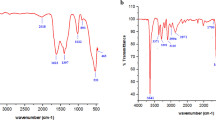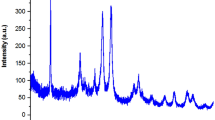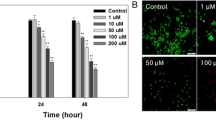Abstract
The current study highlights the apoptotic activity of copper oxide (CuO) nanoparticles functionalized by Glutamic acid and conjugated by thiosemicarbazone (TSC) toward human breast cancer (MCF-7) and normal (HEK293) cell lines. To this aim, the co-precipitation method was used for preparation the CuO nanoparticles. Afterward, the CuO nanoparticles functionalized by glutamic acid. After that the functionalized copper oxide nanoparticles (CuO@Glu) conjugated to thiosemicarbazone. In next step, the final nanoparticle product (CuO@Glu/TSC) was characterized by physico-chemical techniques including Fourier transform infrared (FT-IR) spectroscopy, Scanning electron microscopy (SEM), transmission electron microscopy (TEM), X-ray diffraction (XRD), Energy dispersive X-ray analysis (EDX), zeta potential analysis and dynamic light scattering (DLS). The effects of in vitro cell viability in CuO@Glu/TSC nanoparticles showed the anti-proliferative properties with a dose-dependent manner (IC50 = 133.97 µg/ml). The IC50 of CuO@Glu/TSC on normal cell line was 230.2 µg/ml. This IC50 deference shows high cytotoxicity of CuO@Glu/TSC nanoparticles on tumor cells and low cytotoxicity on non-tumorigenic cells (HEK293) and is considered as an important aspect for this nanoparticles. Also, CuO@Glu/TSC nanoparticles had efficient effects in inhibiting the growth of breast cancer cell line (MCF-7). In addition, the CuO@Glu/TSC nanoparticle induced apoptosis symptoms which were assessed by Caspase-3 activation assay, Annexin V/ propidium iodide flow cytometry, and Hoechst 33258 staining. Further, Bax and Bcl-2 genes expression was estimated by real time PCR. The expression of Bax increased 1.69 fold, while the expression of Bcl-2 decreased 0.6 fold. The results of the current study propose that CuO@Glu/TSC nanoparticles reveal effective anti-cancer activity against breast cancer cell line.











Similar content being viewed by others
Data Availability
The datasets generated during the current study are available from the corresponding author on reasonable request.
References
M. Saravanan, H. Vahidi, D. M. Cruz, A. Vernet-Crua, E. Mostafavi, R. Stelmach, T. J. Webster, et al. (2020). Int J Nanomed. https://doi.org/10.2147/IJN.S240293.
M. Saravanan, H. Barabadi, H. Vahidi, T. J. Webster, D. Medina-Cruz, E. Mostafavi, A. Vernet-Crua, et al. (2021). Handb Nanobiomater Ther Diagnostic Appl. https://doi.org/10.1016/B978-0-12-821013-0.00004-0.
P. S. Kumar and P. Umadevi (2018). Russ. J. Gen. Chem. 1, 100. https://doi.org/10.3390/ph13060111.
H. Muğlu, M. S. Çavuş, T. Bakır, and H. Yakan (2019). J Mol Struct. https://doi.org/10.1016/j.molstruc.2019.07.002.
M. D. Altıntop, Ö. Atlı, S. Ilgın, R. Demirel, A. Özdemir, and Z. A. Kaplancıklı (2016). Eur J Med Chem. https://doi.org/10.1016/j.ejmech.2015.11.041.
A. Nejabatdoust, H. Zamani, and A. Salehzadeh (2019). Microb Drug Resist. https://doi.org/10.1089/mdr.2018.0304.
C. Balachandran, J. Haribabu, K. Jeyalakshmi, N. S. Bhuvanesh, R. Karvembu, N. Emi, and S. Awale (2018). J Inorg Biochem. https://doi.org/10.1016/j.jinorgbio.2018.02.014.
M. Li-Weber (2009). Cancer Treat Rev. https://doi.org/10.1016/j.ctrv.2008.09.005.
F. N. Akladios, S. D. Andrew, and C. J. Parkinson (2016). J Biol Inorg Chem. https://doi.org/10.1007/s00775-016-1390-7.
E. l. Metwally, N. M. R. Arafa, and U. El-Ayaan (2014). J. Therm. Anal. Calorim. https://doi.org/10.1007/s10973-013-3065-8
A. Gupte and R. J. Mumper (2009). Cnacer Treat Rev. https://doi.org/10.1016/j.ctrv.2008.07.004.
J. Wang, M. Sui, and W. Fan (2010). Curr Drug Metab. https://doi.org/10.2174/138920010791110827.
A. Rahnama and M. Gharagozlou (2012). Opt Quant Electron. https://doi.org/10.1007/s11082-011-9540-1.
N. Abbaszadeh, N. Jaahbin, A. Pouraei, F. Mehraban, M. Hedayati, A. Majlesi, F. Akbari, et al (2021). J Clust Sci. https://doi.org/10.1007/s10876-021-01995-9
T. T. Bamgboye and O. A. Bamgboye (1985). Inorg. Chim. Acta 105, 223.
S. A. S. Shandiz, A. Montazeri, M. Abdolhosseini, S. H. Shahrestani, M. Hedayati, Z. Moradi-Shoeili, and A. Salehzadeh (2018). J Clust Sci. https://doi.org/10.1007/s10876-018-1424-0.
B. Dutta, E. Kar, N. Bose, and S. Mukherjee (2015). RSC Adv. https://doi.org/10.1039/C5RA21903E.
E. Joseph and G. Singhvi, William Andrew Publishing, (pp. 91–116). (2019)
R. Shah, D. Eldridge, E. Palombo, and I. Harding (2014). J. Phys. Sci. 25, 59.
A. Loureiro, G. N. Azoia, C. A. Gomes, and A. Cavaco-Paulo (2016). Curr Pharm Des. https://doi.org/10.2174/1381612822666160125114900.
N. H. Abd Ellah and S. A. Abouelmagd (2016). Expert Opin Drug Deliv. https://doi.org/10.1080/17425247.2016.1213238.
T. Khan, R. Ahmad, S. Joshi, and A. R. Khan (2015). Der Chemica Sinica. 6, 1.
S. Z. Habibzadeh, A. Salehzadeh, Z. Moradi-Shoeili, and S. A. S. Shandiz (2020). Mol Biol Rep. https://doi.org/10.1007/s11033-020-05251-7.
M. Bejarbaneh, Z. Moradi-Shoeili, A. Jalali, and A. Salehzadeh (2020). Biol Trace Elem Res. https://doi.org/10.1007/s12011-020-02049-3.
P. C. A. Kam and N. I. Ferch (2000). Anaesthesia. https://doi.org/10.1046/j.1365-2044.2000.01554.x.
B. Sun, N. Hu, L. Han, Y. Pi, Y. Gao, and K. Chen (2019). Artif Cells Nanomed Biotechnol. https://doi.org/10.1080/21691401.2019.1575844.
A. Yaqub, N. Malkani, A. Shabbir, S. A. Ditta, F. Tanvir, S. Ali, and R. Ullah (2020). Artif Cells Nanomed Biotechnol. https://doi.org/10.1080/21691401.2019.1575844.
M. Azizi, H. Ghourchian, F. Yazdian, F. Dashtestani, and H. AlizadehZeinabad (2017). PLoS ONE. https://doi.org/10.1371/journal.pone.0188639.
A. Habibi, S. A. S. Sadat Shandiz, A. Salehzadeh, and Z. Moradi (2020). J Biol Inorg Chem. https://doi.org/10.1007/s00775-019-01728-4.
M. Jarestan, K. Khalatbari, A. Pouraei, S. A. S. Sadat Shandiz, S. Beigi, M. Hedayati, and A. Salehzadeh (2020). 3 Biotech. https://doi.org/10.1007/s13205-020-02230-4.
M. R. Izadpanah, A. Salehzadeh, M. Zaefizadeh, and M. Nikpasand (2020). IET Nanobiotechnol. https://doi.org/10.1049/iet-nbt.2019.0199.
Acknowledgements
We would like to appreciate Dr. Zeinab Moradi-Shoeili for collaborate on the interpretation of chemical spectra.
Funding
This research did not receive any specific grant from funding agencies in the public, commercial, or not-for-profit sectors.
Author information
Authors and Affiliations
Corresponding author
Ethics declarations
Conflict of interest
The authors declare that they have no conflict of interest.
Additional information
Publisher's Note
Springer Nature remains neutral with regard to jurisdictional claims in published maps and institutional affiliations.
Rights and permissions
About this article
Cite this article
Shafiei, I., Tavassoli, S.P., Rahmatollahi, H.R. et al. A Novel Copper Oxide Nanoparticle Conjugated by Thiosemicarbazone Promote Apoptosis in Human Breast Cancer Cell Line. J Clust Sci 33, 2697–2706 (2022). https://doi.org/10.1007/s10876-021-02187-1
Received:
Accepted:
Published:
Issue Date:
DOI: https://doi.org/10.1007/s10876-021-02187-1




